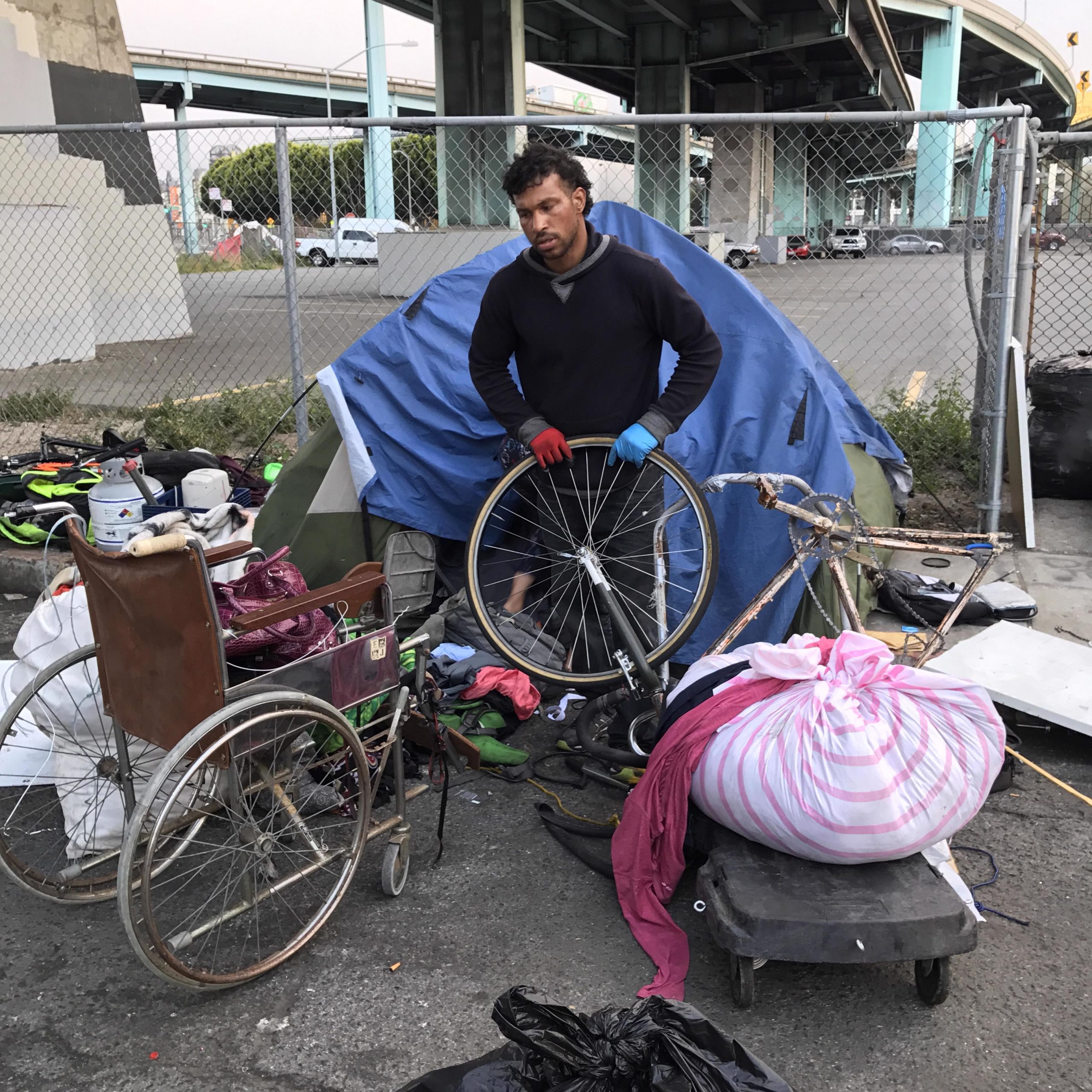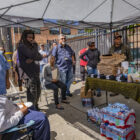As London Breed celebrated victory after her first mayoral race in June 2018, she vowed to rid San Francisco of homeless encampments within a year. That November, less than four months after she took office, she announced a 34 percent reduction in the number of tents and improvised structures citywide. Breed attributed the drop to increased funding for housing, emergency shelters and better coordination.
“There is still plenty of work to be done, but our approach is working,” Breed said at the time in a press release. “We will continue our efforts to ensure that encampments do not return and we connect people with the help they need.”
But the mayor seems to have celebrated too soon. Following the initial drop in late 2018, the city’s own data shows a general upward climb, with a 31 percent increase in tents in 2019 from January to October.
Staff at the Office of the Controller, which oversees the counts, say it is unclear whether the ebb and flow of encampments is a result of the city’s work on the issue or simply a seasonal shift. But the numbers have been hard to nail down because of changing methodology, making trend-spotting difficult until 2019. Counts of tents on the streets last year lacked the standardized instructions and methodology implemented in later counts.
In an on-stage public interview with the San Francisco Chronicle in August 2019, Breed told a rowdy audience that she had worked hard to reduce the number of tents in the city for the sake of public safety.
“There’s feces in a lot of places, and that’s a public health issue,” she said. “There’s needles that we need to clean up. And to allow people to just have tents set up where drug use is happening, where rapes are happening, where other issues are happening — that is not something that I believe is humane and that we need to allow people to do.”
Staff from the city’s Department of Homelessness and Supportive Housing conducted the first tent count on July 2, 2018, just days before Breed took office. Dozens of city workers holding clipboards canvassed the city, marking the location and quantity of tents or makeshift shelters. That morning, they counted 568 tents and improvised structures.
Three months later, a second count conducted by a coalition of city agencies found 378 tents, and in January 2019, city workers counted 341 tents. But further counts conducted this year show that the trend had reversed. In October 2019, the city counted 447 tents, a 31 percent increase from January.
The number of lived-in vehicles also rose steadily since the city began tracking them. According to the San Francisco Chronicle, a separate count conducted by the Department of Homelessness and Supportive Housing in October 2018 found 432 cars and recreational vehicles used as shelter. By October 2019, there were 731 shelter vehicles in the city. (The Office of the Controller began counting vehicles as well as tents in April.)
The vast majority of the tents counted in 2019 were in the Tenderloin, South of Market, Mission and Bayview neighborhoods. More lived-in vehicles were counted in 2019 in supervisorial District 10, which includes the Bayview, than in all other districts combined.
The mayor’s deputy communications director, Andy Lynch, said that the rise in tents counted in 2019 was part of a larger trend in homelessness statewide.
“San Francisco and cities across California have seen a rise in homelessness and a resulting increase in tent encampments and vehicular homelessness,” Lynch wrote in an email. “Our focus is to connect people to shelter and services, and ultimately with housing.”
Cody Reneau, an analyst at the Office the Controller, said there weren’t enough data yet to determine the reason behind the increase. He said the variable tent numbers may represent a seasonal shift.
“In the winter, with the rain, I think it is harder to be outside, and I think that it leads to people either coming into shelter or establishing in places that are more sheltered naturally and so probably less likely to be seen,” he said.
But to Kelley Cutler, an organizer at the Coalition on Homelessness, the seasonal trend doesn’t hold water. She said that if unhoused people were able to find better-sheltered locations to set up their tents that were also invisible to city agencies, they wouldn’t leave that space just because the weather improved, and there are not enough wet-weather shelter beds rolled out each year by the city to account for the difference between the January and October 2019 counts.
To Cutler, the reason for the increase is similar to that offered by the mayor’s office: “It’s because homelessness is increasing.”
Cutler said the city’s counts of tents don’t correlate with rates of homelessness, and that any reduction seen in the number of tents reflected how many tents had been taken from homeless people by city workers, not how many homeless people were no longer sleeping outdoors. She said that if the city truly wanted to track its own progress, it should record the number of people who successfully transfer from homelessness to housing, not tents and vehicles.
“They’re focusing on the visible homelessness of the tent but not on the overall numbers,” she said. Focusing on the tents “doesn’t say anything about somebody getting housing, of getting into shelter — it just tells you that somebody doesn’t have a tent.”
The January 2019 point-in-time count — a biennial initiative to count the number of homeless people living in San Francisco — shows the city’s homeless population grew to 9,784 according to San Francisco’s counting standard. Among those surveyed in the count, more than half said they slept outside — with our without tents, or in vehicles.
City departments acknowledge that the methodology used for early counts in San Francisco was inconsistent.
Reneau said that before the controller began overseeing the counts in April 2019, there wasn’t consistent training for city workers, and the instructions detailing what qualified as improvised structures had yet to be standardized.
“It seems to me, potentially, there was something off there,” he said. “But we just don’t know what it was.”
Because city staff conducted the first three counts in 2018 and early 2019 using paper forms, Reneau said duplicates were easy to miss. For example, the controller reviewed the October 2018 count in February and removed a number of duplicate tent sites from the final report.
Reneau stopped short of saying the first three counts were unreliable. “But we were not monitoring the reliability,” he said. “We don’t know very well how reliable they were.”
Lynch confirmed that standardized training was not implemented early on. He stressed that both the training and instructions subsequently developed were based on the methodology of the early counts. He said the October 2018 and January 2019 tent counts conducted on paper were reliable.
“The counting methodology has improved over time, especially with the transition away from paper, and we’re continuing to improve the process with every count,” he wrote in an email.
Beginning in April 2019, the controller conducted group trainings for staff counting encampments on the streets and established criteria for identifying tents and makeshift shelters. The agency also began using an app, in place since April 2019, which workers used to log each tent, makeshift shelter or lived-in vehicle.
The app pairs entries with GPS location tags, allowing Reneau and a colleague to monitor each worker’s locations as they log new entries, and approve or reject new entries. If they notice two workers counting in the same area, they can tell one to change course and delete duplicates.
“Generally, we have gotten better with the training, documentation and instructions,” Reneau said. “We’re probably just now reaching a true regularity that ensures really high-quality data.”
In response to the homelessness crisis, Lynch said the mayor pushed for the $600 million affordable housing bond passed in November 2019 that would open 1,000 new shelter beds. The mayor and Board of Supervisors reached a deal that same month to provide better mental health care services to the roughly 4,000 homeless people experiencing addiction and mental health issues.
Jeff Kositsky, director of the Department of Homelessness and Supportive Housing, said his department was concerned about the rise this year of tents and lived-in vehicles. He said the city should improve efforts aimed at getting homeless people into programs and housing.
“We need to use data to get those tent counts down by better serving the people in those tents,” he said.









